Battery State of Charge Estimation Based on Composite Multiscale Wavelet Transform
Abstract
:1. Introduction
2. Test Bench and Experimental Data
3. Composite Multiscale Wavelet Transform Method
4. Experimental Results and Analysis
5. Method Validation and Comparison Study
6. Conclusions
Author Contributions
Funding
Institutional Review Board Statement
Informed Consent Statement
Data Availability Statement
Acknowledgments
Conflicts of Interest
References
- Xiong, X.; Wang, S.L.; Fernandez, C.; Yu, C.M.; Zou, C.Y.; Jiang, C. A novel practical state of charge estimation method: An adaptive improved ampere-hour method based on composite correction factor. Int. J. Energy Res. 2020, 44, 11385–11404. [Google Scholar] [CrossRef]
- Luo, Y.; Qi, P.; Huang, H.; Wang, J.; Wang, Y.; Li, P. Study on Battery SOC Estimation by Ampere-hour Integral Method with Capacity Correction. Automot. Eng. 2020, 42, 681–687. [Google Scholar] [CrossRef]
- Knap, V.; Stroe, D.I. Effects of open-circuit voltage tests and models on state-of-charge estimation for batteries in highly variable temperature environments: Study case nano-satellites. J. Power Sources 2021, 498, 229913. [Google Scholar] [CrossRef]
- Gong, D.; Gao, Y.; Kou, Y. Parameter and State of Charge Estimation Simultaneously for Lithium-Ion Battery Based on Improved Open Circuit Voltage Estimation Method. Energy Technol. 2021, 9, 2100235. [Google Scholar] [CrossRef]
- Malepati, B.S.; Vijay, D.; Deb, D.; Manjunath, K. Parameter validation to ascertain voltage of Li-ion battery through adaptive control. Adv. Intell. Syst. Comput. 2019, 757, 21–31. [Google Scholar] [CrossRef]
- Sun, L.; Li, G.; You, F. Combined internal resistance and state-of-charge estimation of lithium-ion battery based on extended state observer. Renew. Sustain. Energy Rev. 2020, 131, 109994. [Google Scholar] [CrossRef]
- Lin, X.; Tang, Y.; Ren, J.; Wei, Y. State of charge estimation with the adaptive unscented Kalman filter based on an accurate equivalent circuit model. J. Energy Storage 2021, 41, 102840. [Google Scholar] [CrossRef]
- Fang, Y.; Zhang, Q.; Zhang, H.; Xu, W.; Wang, L.; Shen, X.; Yun, F.; Cui, Y.; Wang, L.; Zhang, X. State-of-charge estimation technique for lithium-ion batteries by means of second-order extended Kalman filter and equivalent circuit model: Great temperature robustness state-of-charge estimation. IET Power Electron. 2021, 14, 1515–1528. [Google Scholar] [CrossRef]
- Jiang, C.; Wang, S.; Wu, B.; Fernandez, C.; Xiong, X.; Coffie-Ken, J. A state-of-charge estimation method of the power lithium-ion battery in complex conditions based on adaptive square root extended Kalman filter. Energy 2021, 219, 119603. [Google Scholar] [CrossRef]
- Khan, H.F.; Hanif, A.; Ali, M.U.; Zafar, A. A Lagrange multiplier and sigma point Kalman filter based fused methodology for online state of charge estimation of lithium-ion batteries. J. Energy Storage 2021, 41, 102843. [Google Scholar] [CrossRef]
- Xiao, F.; Li, C.; Fan, Y.; Yang, G.; Tang, X. State of charge estimation for lithium-ion battery based on Gaussian process regression with deep recurrent kernel. Int. J. Electr. Power Energy Syst. 2021, 124, 106369. [Google Scholar] [CrossRef]
- Deng, Z.; Hu, X.; Lin, X.; Che, Y.; Xu, L.; Guo, W. Data-driven state of charge estimation for lithium-ion battery packs based on Gaussian process regression. Energy 2020, 205, 118000. [Google Scholar] [CrossRef]
- Dhiman, H.S.; Deb, D.; Muyeen, S.M. Lithium-Ion Battery Prognostics based on Support Vector Regression and Time-Series Analysis. In Proceedings of the 2021 IEEE 4th International Conference on Computing, Power and Communication Technologies, GUCON 2021, Kuala Lumpur, Malaysia, 24–26 September 2021. [Google Scholar] [CrossRef]
- Chen, J.; Feng, X.; Jiang, L.; Zhu, Q. State of charge estimation of lithium-ion battery using denoising autoencoder and gated recurrent unit recurrent neural network. Energy 2021, 227, 120451. [Google Scholar] [CrossRef]
- Tian, J.; Xiong, R.; Shen, W.; Lu, J. State-of-charge estimation of LiFePO4 batteries in electric vehicles: A deep-learning enabled approach. Appl. Energy 2021, 291, 116812. [Google Scholar] [CrossRef]
- Zhang, L.; Zheng, M.; Du, D.; Li, Y.; Fei, M.; Guo, Y.; Li, K. State-of-charge estimation of lithium-ion battery pack based on improved RBF neural networks. Complexity 2020, 2020, 8840240. [Google Scholar] [CrossRef]
- Guo, Y.; Yang, Z.; Liu, K.; Zhang, Y.; Feng, W. A compact and optimized neural network approach for battery state-of-charge estimation of energy storage system. Energy 2021, 219, 119529. [Google Scholar] [CrossRef]
- Zhao, X.; Xuan, D.; Zhao, K.; Li, Z. Elman neural network using ant colony optimization algorithm for estimating of state of charge of lithium-ion battery. J. Energy Storage 2020, 32, 101789. [Google Scholar] [CrossRef]
- Feng, X.; Chen, J.; Zhang, Z.; Miao, S.; Zhu, Q. State-of-charge estimation of lithium-ion battery based on clockwork recurrent neural network. Energy 2021, 236, 121360. [Google Scholar] [CrossRef]
- Patel, P.; Shandilya, A.; Deb, D. Optimized hybrid wind power generation with forecasting algorithms and battery life considerations. In Proceedings of the 2017 IEEE Power and Energy Conference at Illinois, PECI 2017, Champaign, IL, USA, 23–24 February 2017. [Google Scholar] [CrossRef]
- Patel, P.; Deb, D. Battery state of charge based algorithm for optimal wind farm power management. In Proceedings of the 2017 6th International Conference on Computer Applications in Electrical Engineering-Recent Advances, CERA 2017, Roorkee, India, 5–7 October 2017; pp. 42–46. [Google Scholar] [CrossRef]
- Wang, Q.; Gu, H.; Ye, M.; Wei, M.; Xu, X. State of Charge Estimation for Lithium-Ion Battery Based on NARX Recurrent Neural Network and Moving Window Method. IEEE Access 2021, 9, 83364–83375. [Google Scholar] [CrossRef]
- Bian, X.; Wei, Z.G.; Li, W.; Pou, J.; Sauer, D.U.; Liu, L. State-of-Health Estimation of Lithium-Ion Batteries by Fusing an Open Circuit Voltage Model and Incremental Capacity Analysis. IEEE Trans. Power Electron. 2022, 37, 2226–2236. [Google Scholar] [CrossRef]
- Yu, J.; Mo, B.; Tang, D.; Yang, J.; Wan, J.; Liu, J. Indirect State-of-Health Estimation for Lithium-Ion Batteries under Randomized Use. Energies 2017, 10, 2012. [Google Scholar] [CrossRef] [Green Version]
- Da Rosa, M.M.; Seidel, H.B.; Paim, G.; Da Costa, E.A.; Almeida, S.; Bampi, S. An Energy-Efficient Haar Wavelet Transform Architecture for Respiratory Signal Processing. IEEE Trans. Circuits Syst. II Express Briefs 2021, 68, 597–601. [Google Scholar] [CrossRef]
- Cao, L.; Li, H.; Zhang, Y.; Zhang, L.; Xu, L. Hierarchical method for cataract grading based on retinal images using improved Haar wavelet. Inf. Fusion 2020, 53, 196–208. [Google Scholar] [CrossRef]
- Chaoui, H.; Ibe-Ekeocha, C.C.; Gualous, H. Aging prediction and state of charge estimation of a LiFePO4 battery using input time-delayed neural networks. Electr. Power Syst. Res. 2017, 146, 189–197. [Google Scholar] [CrossRef]
- Shao, Y.E.; Lin, S.C. Using a time delay neural network approach to diagnose the out-of-control signals for a multivariate normal process with variance shifts. Mathematics 2019, 7, 959. [Google Scholar] [CrossRef] [Green Version]
- Hossain Lipu, M.S.; Hannan, M.A.; Hussain, A.; Ayob, A.; Saad, M.H.; Muttaqi, K.M. State of charge estimation in lithium-ion batteries: A neural network optimization approach. Electronics 2020, 9, 1546. [Google Scholar] [CrossRef]
- Hossain Lipu, M.S.; Hannan, M.A.; Hussain, A.; Ayob, A.; Saad, M.H.; Karim, T.F.; How, D.N. Data-driven state of charge estimation of lithium-ion batteries: Algorithms, implementation factors, limitations and future trends. J. Clean. Prod. 2020, 277, 124110. [Google Scholar] [CrossRef]

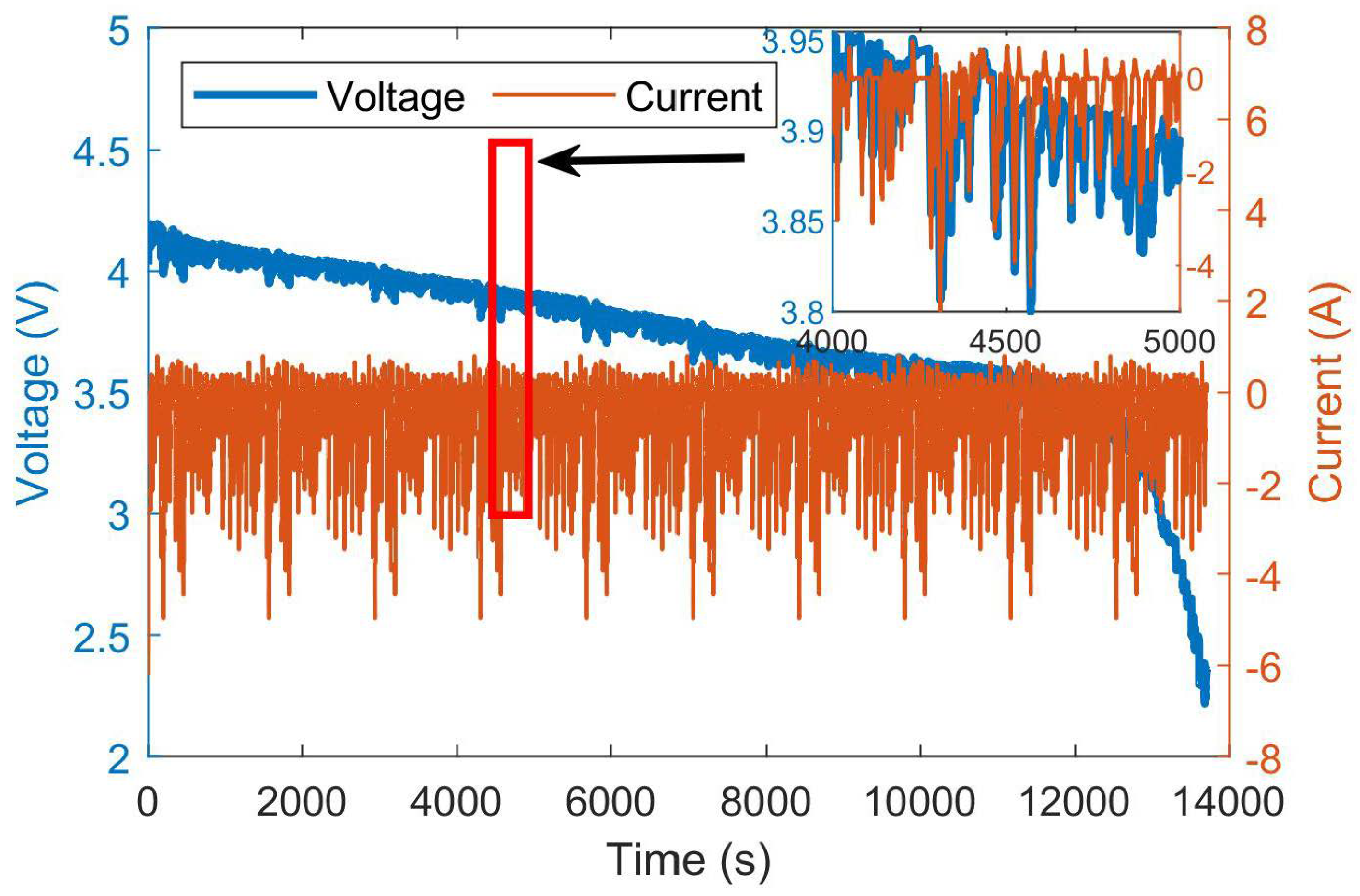

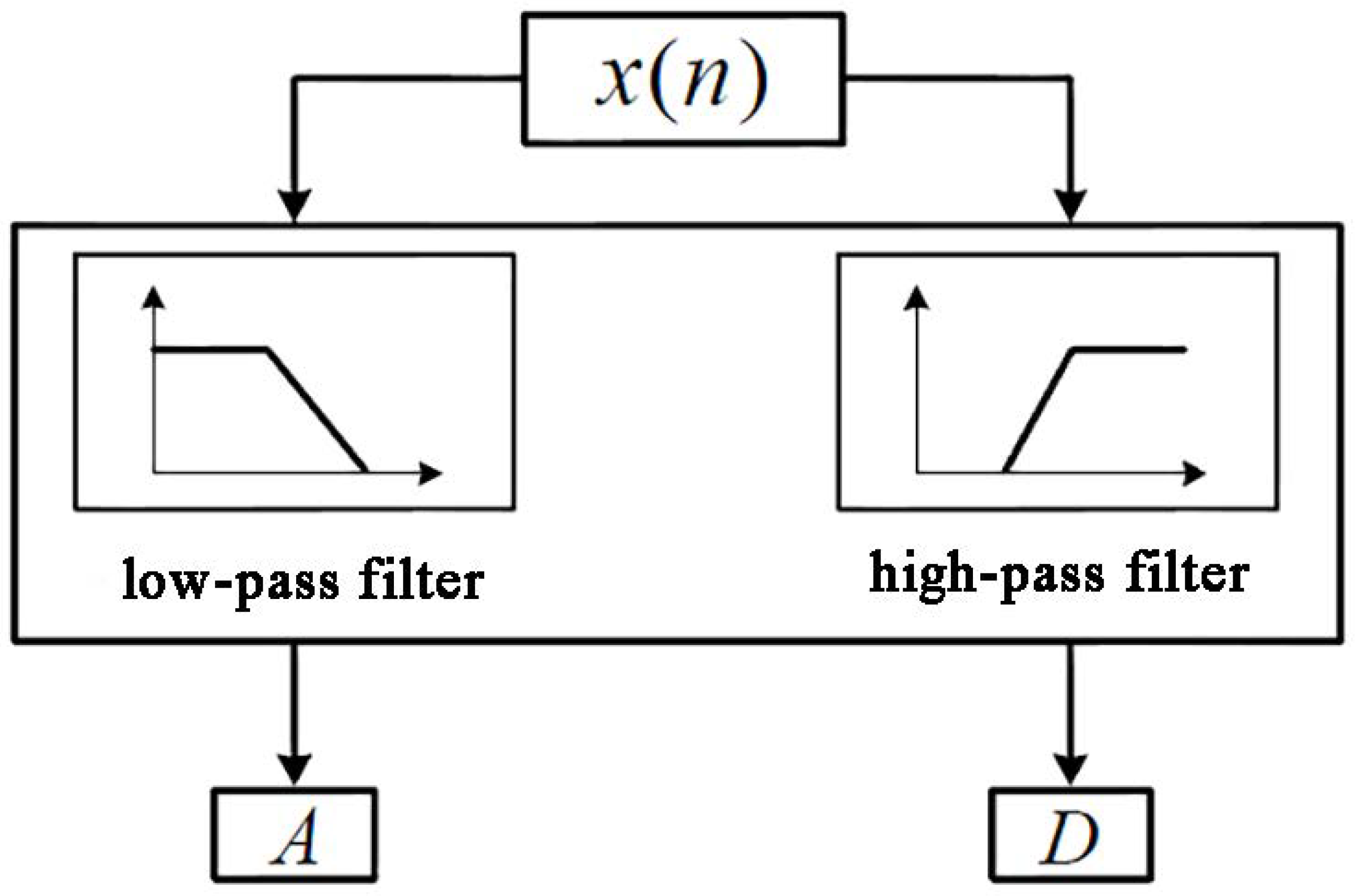

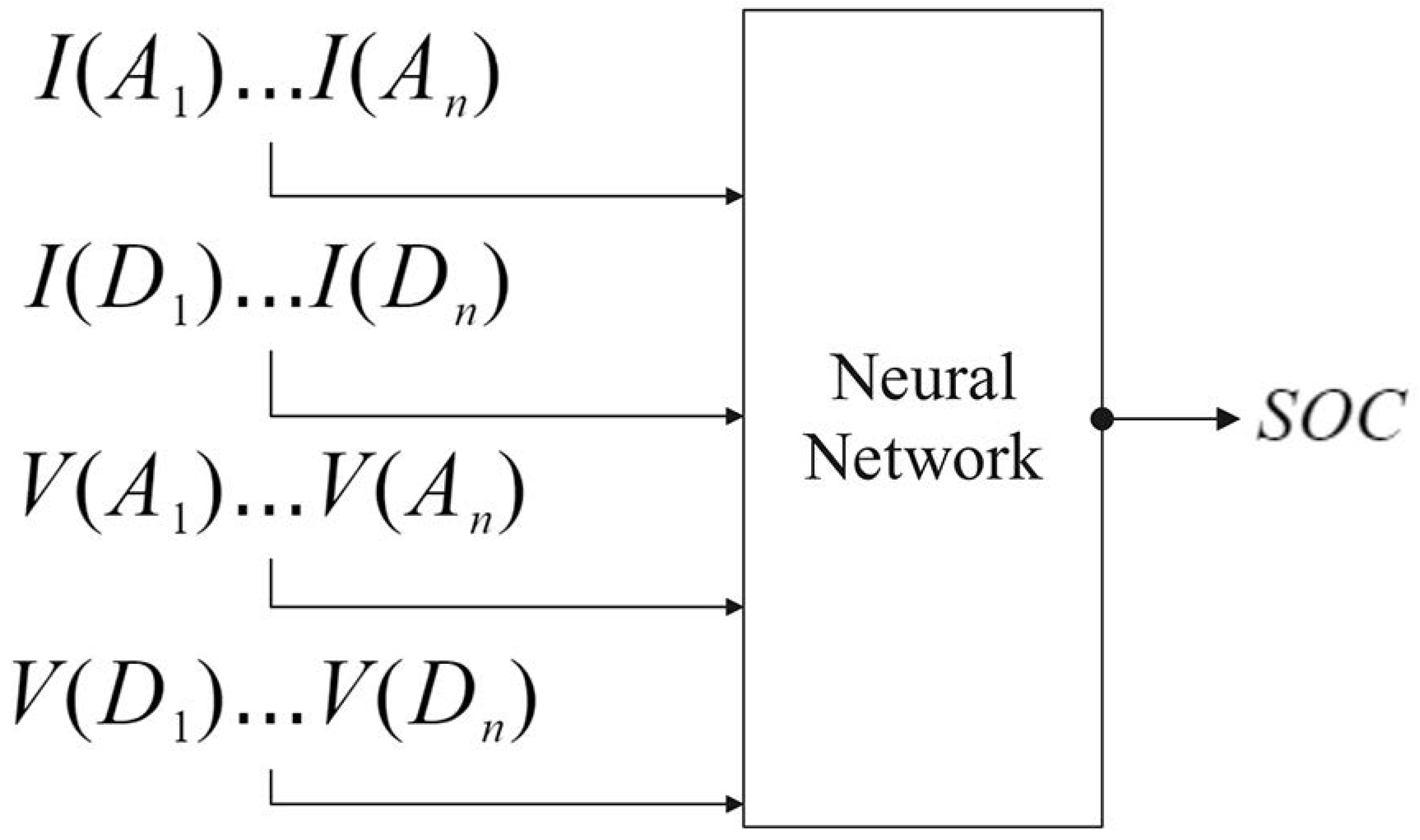
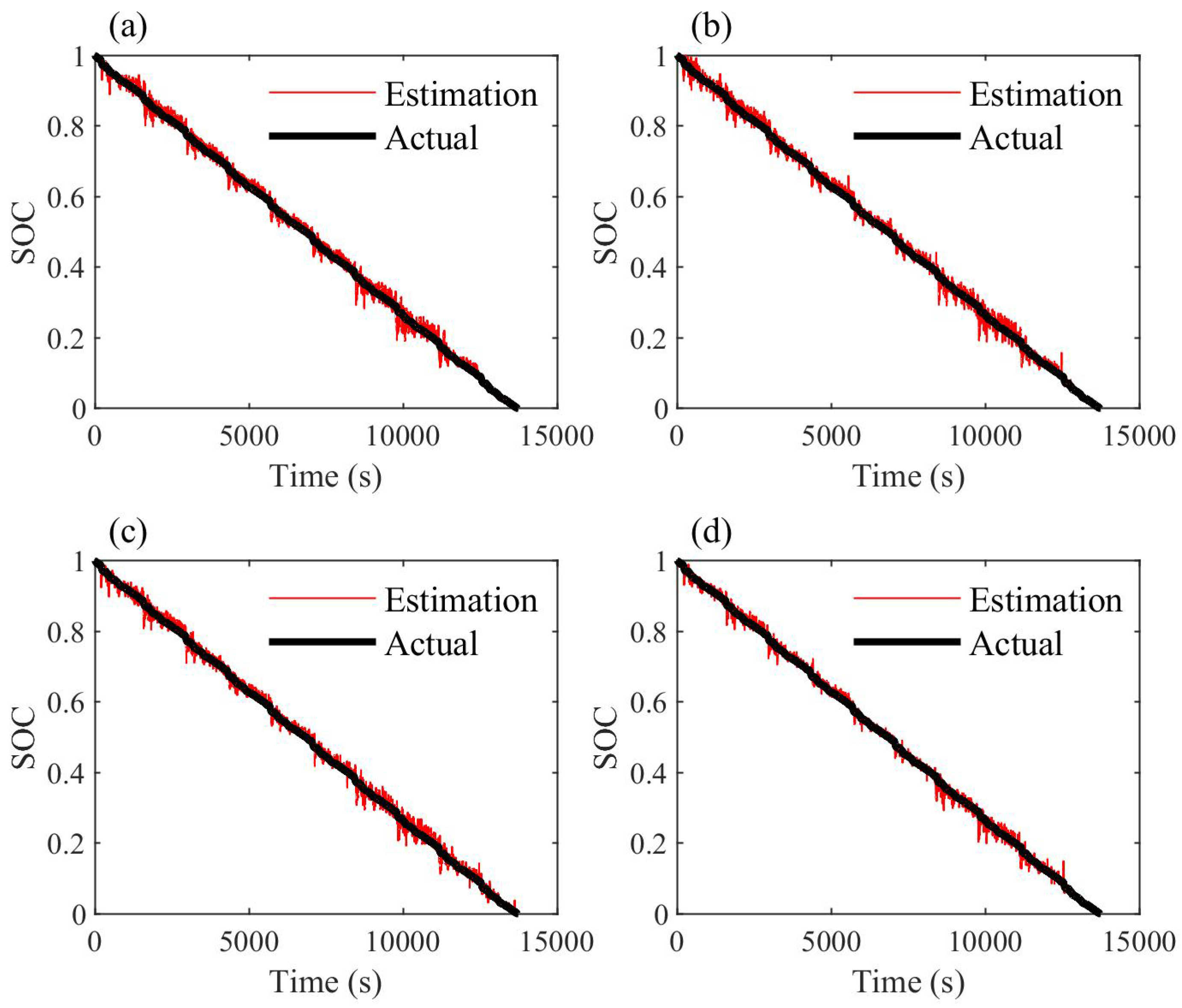

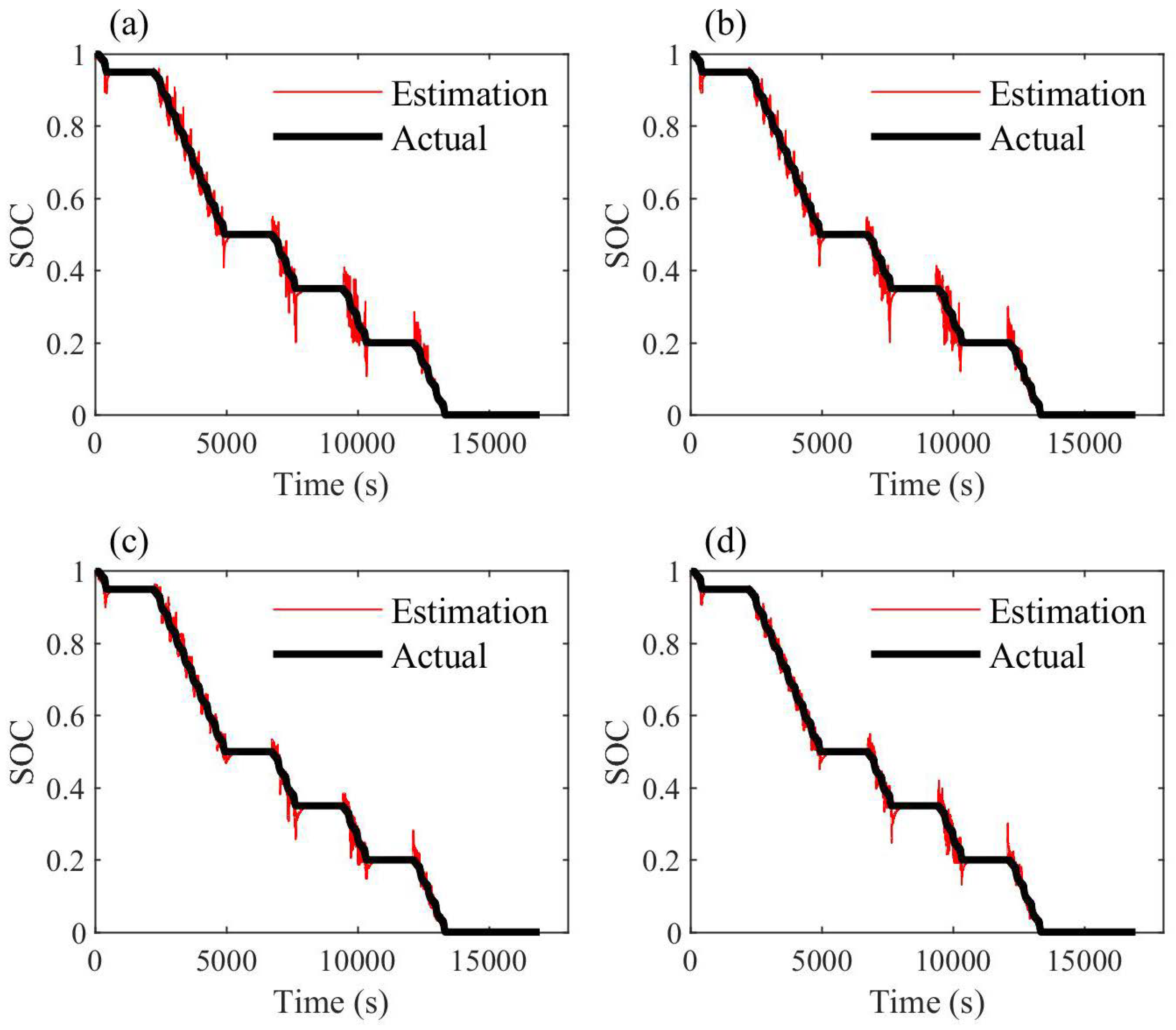
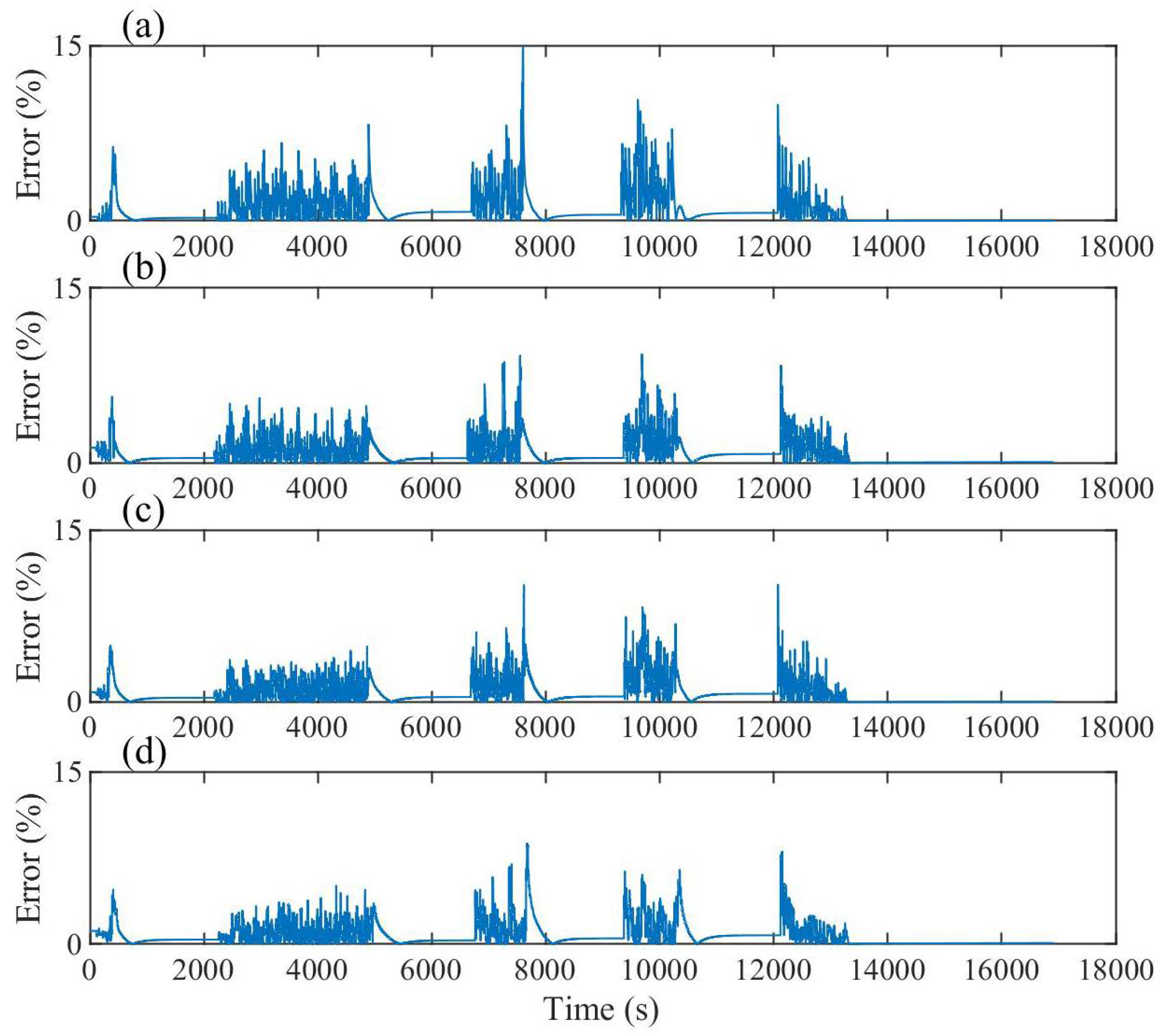
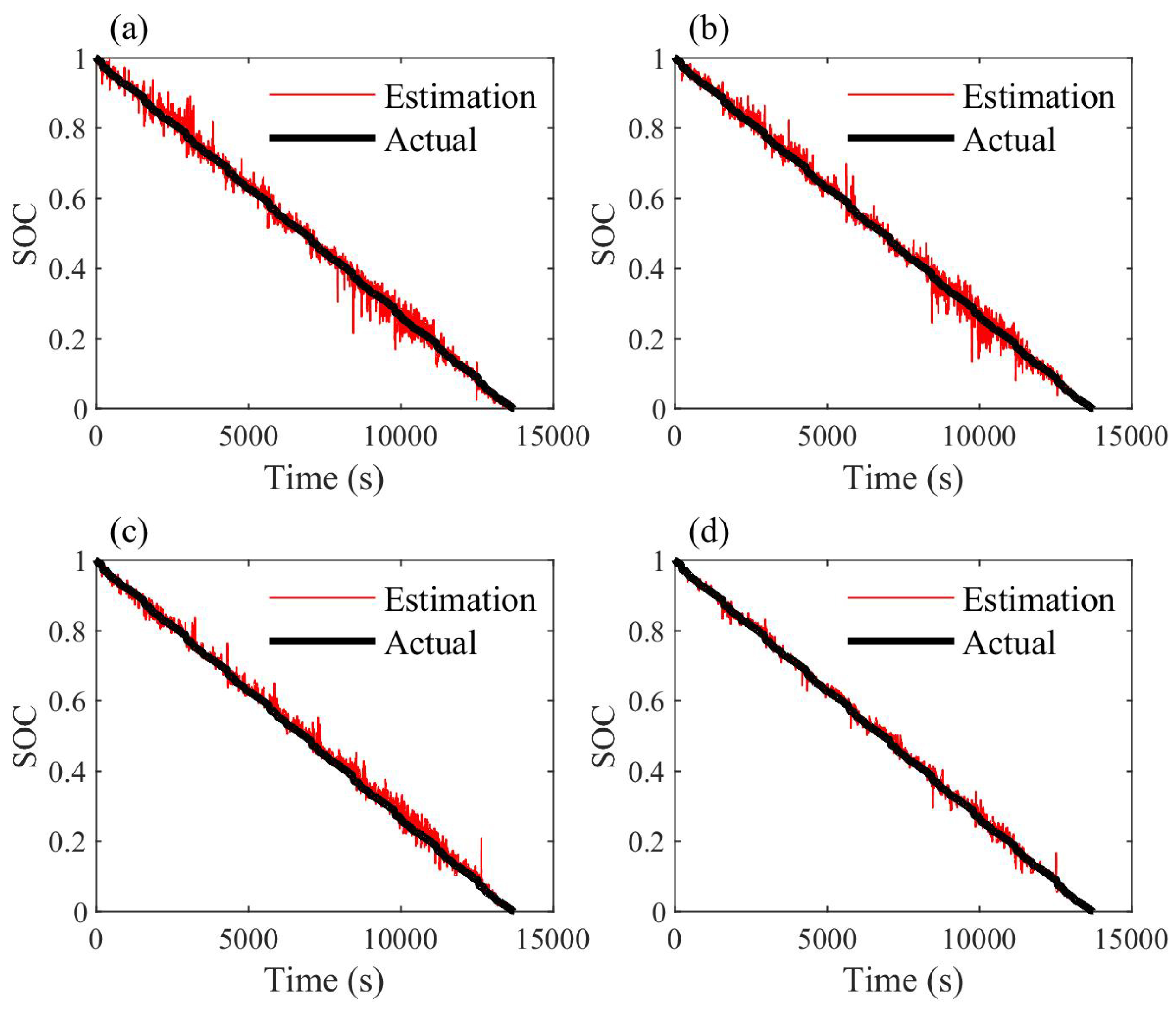
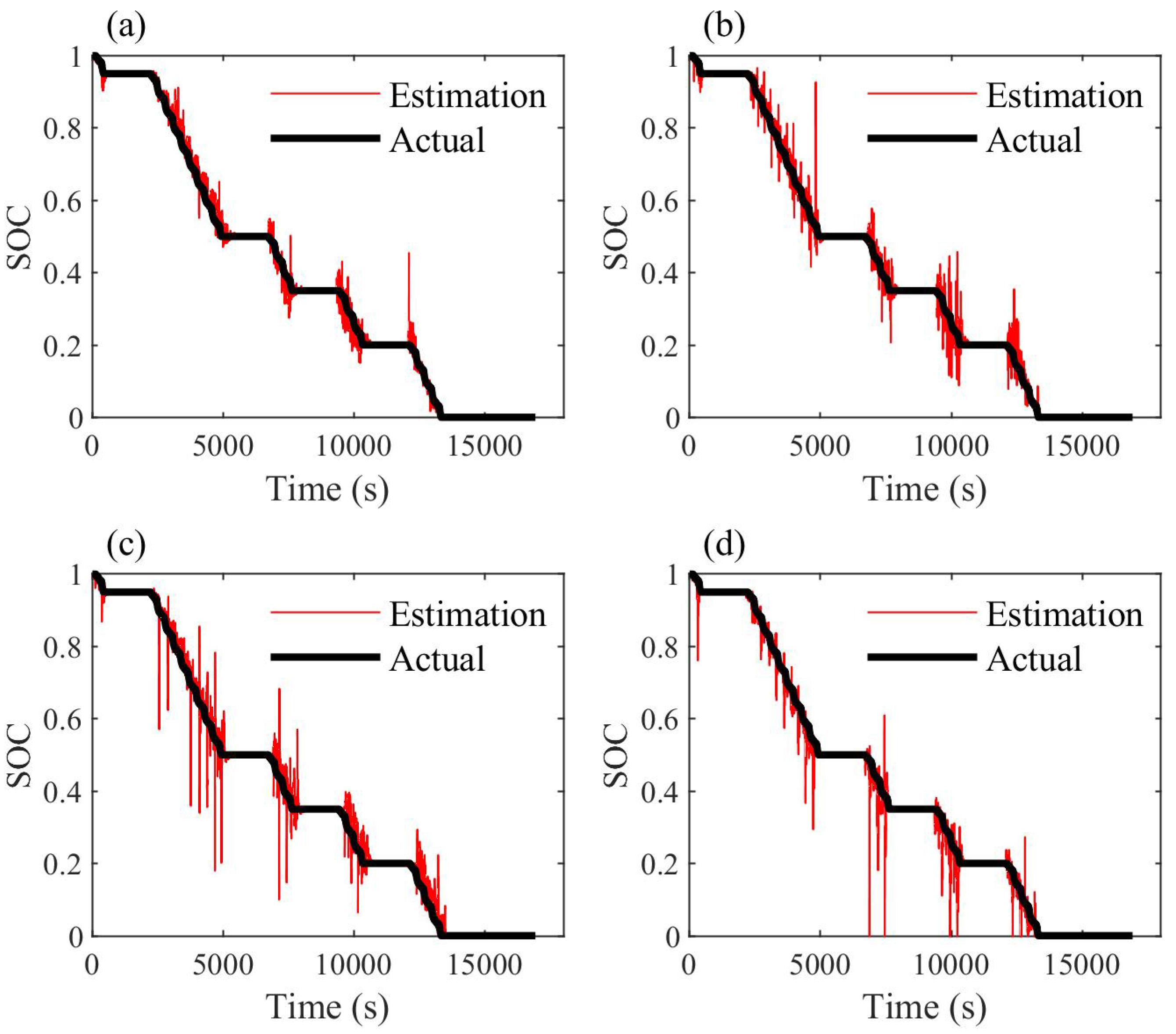
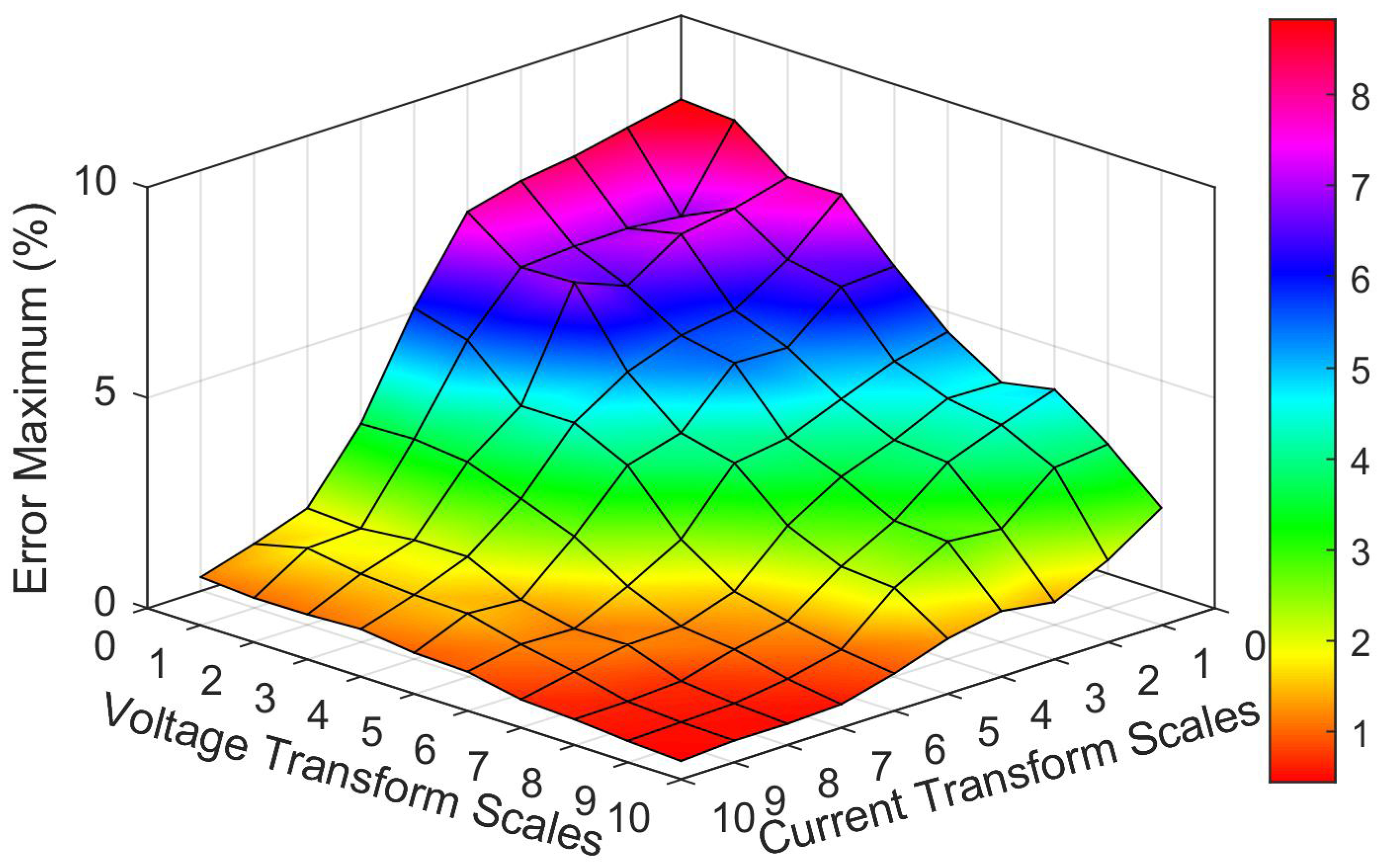
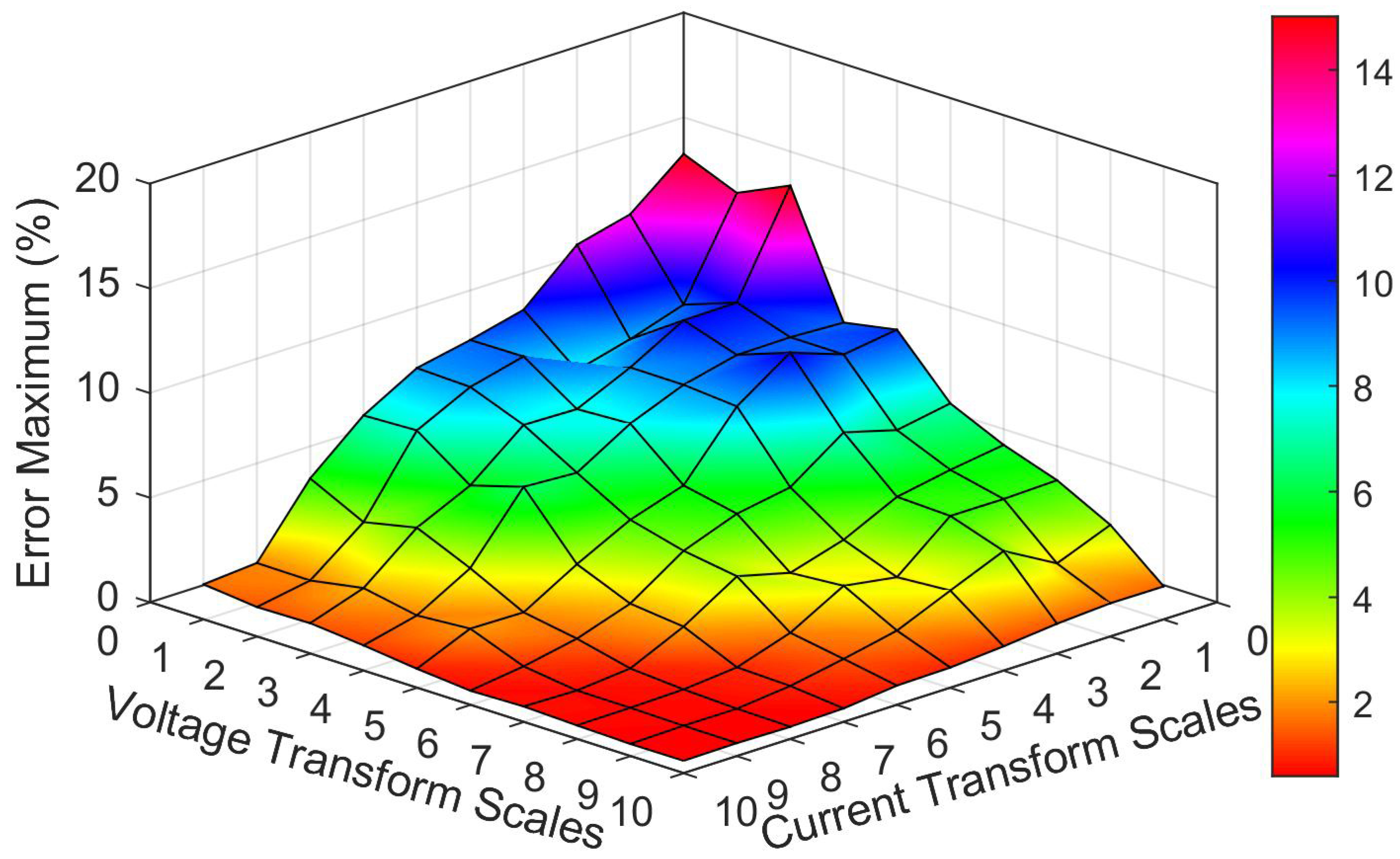



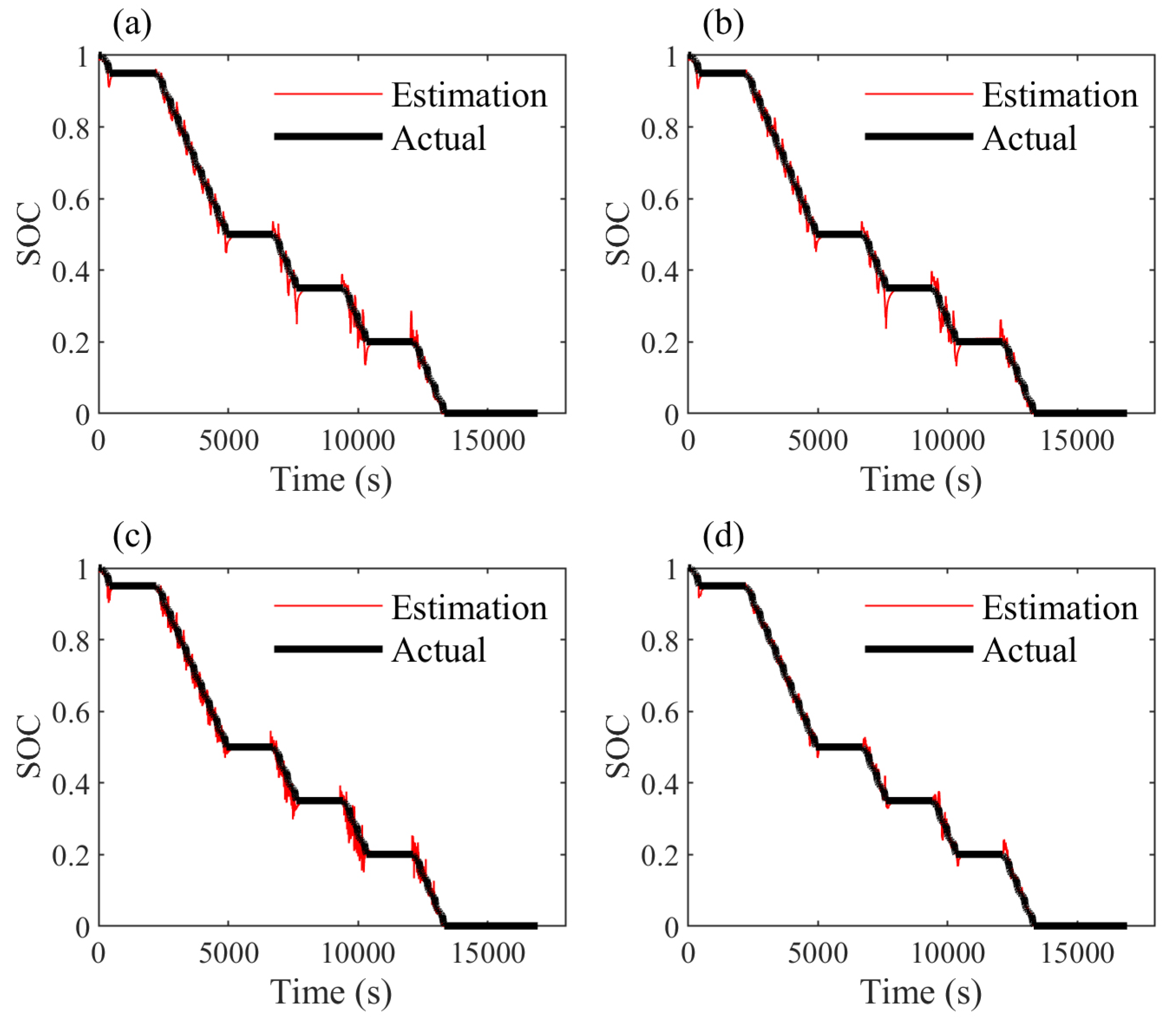
| Nominal Voltage | Nominal Capacity | Working Voltage | Maximum Current |
|---|---|---|---|
| 3.6 V | 1.5 Ah | 2.5–4.2 V | 15 A (20 C) |
| Parameter | Value |
|---|---|
| Input node number | Approximate parameters and detail parameters after wavelet transform |
| Hidden node number | 32 |
| Output node number | 1(SOC) |
| Termination condition | MSE = |
| Activation function | Log-Sigmoid |
| Training algorithm | Levenberg–Marquardt Algorithm |
| Termination generation | 2000 |
| Neutral Network Mode | UDDS | DST | ||
|---|---|---|---|---|
| MSE | Maximum | MSE | Maximum | |
| First mode | 1.88 | 8.85% | 2.36 | 14.90% |
| Second mode | 1.71 | 8.80% | 2.36 | 9.30% |
| Third mode | 1.5 | 8.70% | 1.54 | 10.20% |
| Fourth mode | 1.15 | 7.50% | 1.38 | 8.70% |
| Profiles | Timed Delay | MSE | Maximum |
|---|---|---|---|
| UDDS | 2 | 2.71 | 16.56% |
| 4 | 3.12 | 14.30% | |
| 8 | 2.67 | 12.20% | |
| 16 | 1.26 | 9.20% | |
| DST | 2 | 1.9 | 25.96% |
| 4 | 3.7 | 40.09% | |
| 8 | 6.15 | 39.34% | |
| 16 | 5.13 | 46.96% |
| RBF Neutral Network Mode | UDDS | DST | ||
|---|---|---|---|---|
| MSE | Maximum | MSE | Maximum | |
| First mode | 2.03 | 9.60% | 2.84 | 15.20% |
| Second mode | 1.96 | 8.41% | 2.08 | 9.00% |
| Third mode | 2.43 | 7.85% | 1.02 | 8.70% |
| Fourth mode | 2.25 | 6.19% | 1.56 | 8.00% |
| Pre-Processing Method | UDDS | DST | ||
|---|---|---|---|---|
| MSE | Maximum | MSE | Maximum | |
| Average value | 0.91 | 4.60% | 1.78 | 10.00% |
| Moving average filter | 0.98 | 5.80% | 2.1 | 11.30% |
| Finite impulse response | 0.97 | 6.30% | 0.92 | 6.70% |
| Wavelet transform | 0.86 | 4.10% | 0.7 | 5.50% |
| Pre-Processing Method | UDDS | DST | ||
|---|---|---|---|---|
| Training Time (s) | Estimation Time (s) | Training Time (s) | Estimation Time (s) | |
| Average value | 14.93 | 0.045 | 14.76 | 0.047 |
| Moving average filter | 12.21 | 0.047 | 14.62 | 0.054 |
| Finite impulse response | 23.62 | 0.062 | 28.82 | 0.071 |
| Wavelet transform | 22.83 | 0.060 | 27.75 | 0.093 |
Publisher’s Note: MDPI stays neutral with regard to jurisdictional claims in published maps and institutional affiliations. |
© 2022 by the authors. Licensee MDPI, Basel, Switzerland. This article is an open access article distributed under the terms and conditions of the Creative Commons Attribution (CC BY) license (https://creativecommons.org/licenses/by/4.0/).
Share and Cite
Cheng, Y.; Zhang, X.; Wang, X.; Li, J. Battery State of Charge Estimation Based on Composite Multiscale Wavelet Transform. Energies 2022, 15, 2064. https://doi.org/10.3390/en15062064
Cheng Y, Zhang X, Wang X, Li J. Battery State of Charge Estimation Based on Composite Multiscale Wavelet Transform. Energies. 2022; 15(6):2064. https://doi.org/10.3390/en15062064
Chicago/Turabian StyleCheng, Yan, Xuesen Zhang, Xiaoqiang Wang, and Jianhua Li. 2022. "Battery State of Charge Estimation Based on Composite Multiscale Wavelet Transform" Energies 15, no. 6: 2064. https://doi.org/10.3390/en15062064





